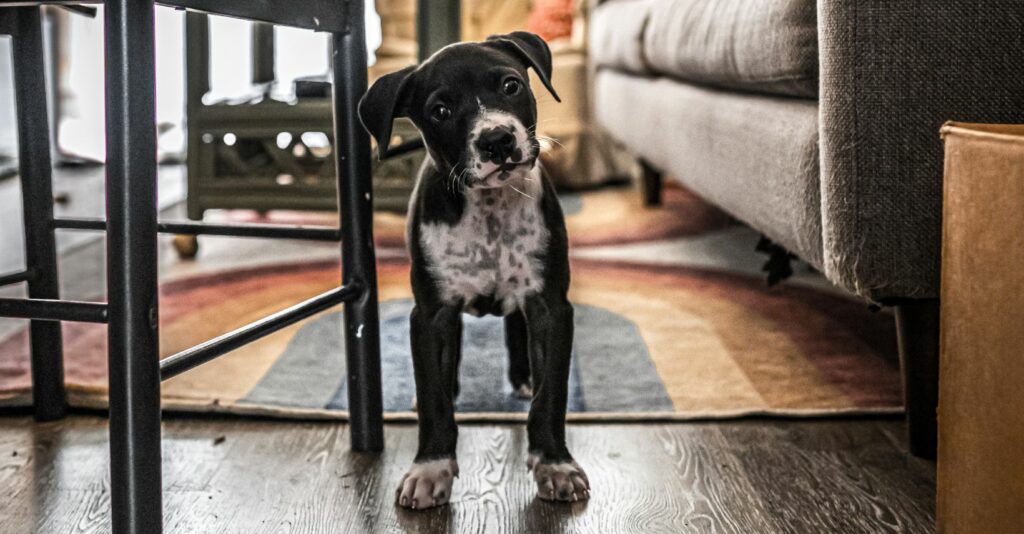New beginnings: A guide to puppy training

Puppies bring endless love and joy to your life. They also require patience, consistency, and some guidance to ensure they become well-mannered, happy members of your family.
If you’ve recently welcomed a puppy into your home or are preparing for their future arrival, it’s essential to understand the unique challenges and opportunities of training a puppy.
To help you with your puppy training journey, we gathered advice from two experienced AnimalKind dog trainers – Bonnie Hartney and Sandy Reichert – who explore two crucial aspects of puppyhood: socialization and teaching a puppy not to bite, a.k.a. teaching appropriate chewing.
It’s time to discover how you can train your puppy:
- Socialization – Bonnie Hartney of Ocean Park Dog Training
- Training appropriate chewing to puppies – Sandy Reichert, Daisy Dog Training
Socialization
Bonnie Hartney, Ocean Park Dog Training
Your puppy is in the “sensitive period for socialization,” (three to 12-14 weeks old), a time they are primed for learning about their world. It is also when the puppy’s brain is growing quickly.
With lots of positive and varied experiences, your puppy will have the best chance of becoming a confident and friendly adult dog.
How can I help my dog with socialization?
You can help your dog with socialization by imagining your future together. Maybe you would like to attend social gatherings, drive on road trips, sit at a cafe, visit the doggy groomer and more. Begin providing lots of gentle and positive exposure to each activity, including the sight, sound, smell, feel and movement of things. With each new experience, offer a tasty food treat to build good feelings about it.
Any safe opportunity for your puppy to experience something new will go a long way.
It is also important to protect your puppy from scary things. Those memories could be lasting. When your puppy is worried, move back or decrease the exposure to the activity or thing.
Some of the really big-ticket items to include:
- Strangers and people of all ages wearing a variety of clothing
- Friendly dogs (from a safe distance or in supervised puppy play)
- Traffic sounds and movement of things with wheels
- Body-handling and tools for grooming and veterinary visits
- Sounds of all kinds

What are the main “don’ts” of socialization?
- Avoid scaring the puppy: Fear is easy to get, hard to get rid of and sometimes impossible to change..
- Avoid over-handling: Dogs prefer to walk than be carried, so start early and call them to come and give treats when they get there. Many puppies become cranky and snappy when hands come at them too often.
- Don’t go to dog parks: The risk of being overwhelmed by exuberant adult dogs is high. You may also be exposing your puppy to disease. (Instead, enroll in a puppy socialization class with opportunities to meet and play with other puppies in a safe and controlled setting.)
- Resist the urge to focus on obedience-type training: You will have lots of time to build manners, but for now, the main goal is good socialization.
How much time should I spend on socializing activities per week?
Puppies are always learning, so unless the puppy is asleep, consider it prime time to socialize.
To stay home in a familiar and unchanging environment is easy but, unfortunately, carries the risk that your puppy’s brain will grow to view this as safe and anything else as dangerous. Remember that socialization is time sensitive, so head out on a socialization field trip. Your puppy’s future is definitely worth it!

Training appropriate chewing to puppies
Sandy Reichert, Daisy Dog Training
Puppies love to bite and chew on everything, and this behaviour is a very normal part of puppy development.
Why do puppies want to chew on everything?
Puppies use biting and chewing as a way to play, explore and engage with the world around them. They may also chew and bite more frequently when they start teething, likely to soothe irritated gums.
Chewing behaviour diminishes as your pup gets older, so having a strategy to get you through these few bitey months will be your best course of action.
What can I do about my puppy chewing?
Be prepared by having a safe, puppy-proof environment.
Put away shoes and remove all electric cords. Supply lots of age-appropriate toys, chews, and long play ropes that allow plenty of space between your hand and those piranha teeth.
Avoid toys that aren’t specifically designed for puppies, as well as chews that may be too hard for their teeth such as antler chews.
Teach your puppy what they should be chewing on by redirecting them to the toys that they are allowed to chew on, rather than following after them saying ‘no,’ when they pick up something inappropriate. .
The best way to address your puppy’s chewing behaviour is to have a strategy that includes creating a safe environment, removing tempting not-chewable items and hazards, and providing plenty of appropriate toys. This stage will pass, so just be ready to guide your pup through it!

You are embarking on a journey!
Training a puppy is a journey that requires dedication and patience. The good news is that you can set your puppy up for success in essential areas like appropriate chewing and socialization.
As your puppy grows into an adolescent dog, new challenges will arise. To continue your training journey, be sure to check out Training your adolescent dog, where we dive into the unique strategies for training and guiding adolescent dogs.
Happy training!
For more expert tips and guidance on training and caring for your dog, be sure to come back and explore:
